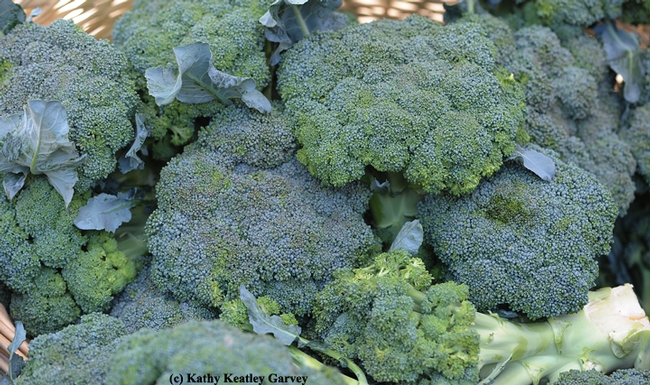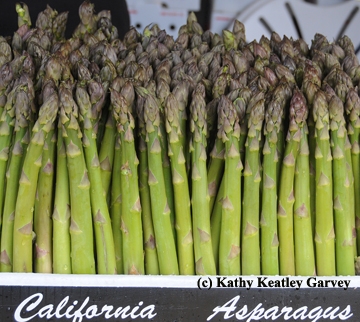The joy of eating green: Ten things you should know about saving money and eating healthier
You skipped breakfast and you're walking into the supermarket without a shopping list. Distracted by several two-legged and four-legged members of your household trying to compete for your attention, you left the list clipped to your refrigerator door.
You're famished. The potato chips look good. The glazed doughnuts look even better. And that chocolate candy bar? To die for.
Bring ‘em on!
No, wait a minute. Let's get real, let's get green and let's get healthy. And let's save some money.
Nutritionist Amy Block Joy, Cooperative Extension specialist emeritus, teaches a University of California, Davis, freshman class on “Eating Green” and we asked her for the 10 best ways to save money and eat healthier.
Joy, who holds a doctorate in nutritional sciences from UC Berkeley, specializes in nutrition and health disparities of diverse populations and nutritional ecology, as well as workplace ethics.
Her advice needs to be posted on every refrigerator in the country. (Along with that shopping list!)
- Shop with a list: Using a list will keep you focused on meal planning and reduce the temptation to buy unneeded items.
- Don't shop when you're hungry: Temptation is high when you're hungry. Eat first and you'll be less inclined to spend extra dollars on those food items placed near the check-out stand that are high in calories and fat and low in nutrition. That would be snacks! Try shopping after a meal and you will find yourself less tempted by those chocolate-covered pretzels!
-
Read the nutrition facts label: When shopping for the healthiest foods, you should read the nutrition fact labels to check out fat, calories, fiber, carbohydrates and sodium. Aim for low-fat, high-fiber foods that have essential vitamins and minerals. For example, if you want the best source of fiber - buy fresh oranges and eat them raw rather than selecting orange juice. However, if you want juice, be sure that you are getting real juice. And, some juices are now fortified with calcium - a big plus for increasing your calcium intake if you are not drinking milk.
- Read the ingredient lists: The ingredient list will provide important clues on products that you'll want to include in your diet. One of them is to look for whole grains. The information on the product may make you think the product is "natural" but what does that really mean? Not much because the phrase you want to look for is the "USDA organic" label. With so many choices of breads these days, you'll want to find ones that have whole grains and fiber. Find the information by reading the label (compare fiber amounts) and ingredients (look for "whole" grains).
-
Compare prices: Supermarkets provide price-comparison information located by their products. You can compare the "unit" costs so that you'll be able to determine the lowest cost of the product. Two words of caution: products "on sale" may not be the best bargains.
- Shop the perimeter of the store: Marketing experts have placed the healthiest foods at the farthest corners of the store so that the shopper has to stroll through the other items before finding fruits and vegetables, protein sources (poultry, meats), dairy products and cereal products.
- Think protein: Buy meat and poultry on sale and use these foods to make stews, soups and chili. This way you can stretch these more expensive food sources. Beans are a great source of protein and are low fat and high in fiber.
- Plan meals ahead: The best way to save money is to plan your meals in advance. Buying unprocessed foods will improve your health and also save money. It costs to add preservatives, food additives and packaging of products that you, the consumer, are paying for. It's much cheaper to buy rice in bulk rather than already prepared rice products. Brown rice contains more fiber than white rice.
- Cook! Your grandmother was right. Food prepared from scratch will taste better, be healthier and save money. Research has shown that cooking not only saves money but improves nutrition.
- Enjoy! Food is meant to be a pleasant happy experience. Don't forget to enjoy it!
So, the next time you're racing out the door on your way to the supermarket, be sure to eat first so you're not tempted by foods that you know aren't good for you.
And that shopping list? You can also key that in on your cell phone so neither the list, nor your phone, will get left behind.
Meanwhile, we all ought to follow Amy Block Joy's great advice on saving money, eating green, and being healthier.
As I wrote on one of my college essays, "We have a choice in the matter and it matters that we have a choice."

The produce aisle is a good place to "go green and eat healthier." (Photo by Kathy Keatley Garvey)

Grocery stores usually place fruits and vegetables around the perimeter. (Photo by Kathy Keatley Garvey)

Broccoli--a food everyone should love. (Photo by Kathy Keatley Garvey)




Posted by Michael Dunstan on April 23, 2014 at 3:51 PM